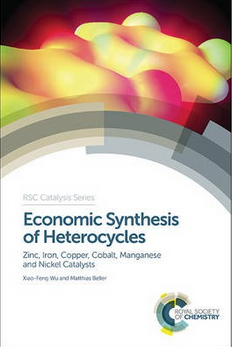
Economic Synthesis of Heterocycles: Zinc, Iron, Copper, Cobalt, Manganese and Nickel Catalysts
[BOOK DESCRIPTION]
Heterocycle synthesis is one of the largest areas of modern organic chemistry. Heterocycles have a broad range of applications including pharmaceuticals, agrochemicals and dyes, and are the core structure to around 90% of naturally-occurring molecules. Transition metal catalysts have become favoured in heterocycle synthesis, not least because of their low cost, but also due to their relatively low environmental toxicity and biocompatibility. This book presents an overview of the state-of-the-art in transition metal catalysis for heterocycle synthesis. Each metal is discussed in turn, presenting a comprehensive source of information on the use of zinc, iron, copper, cobalt, manganese, and nickel in a sustainable and economic manner. Referencing the latest primary literature, and authored by active researchers in the field, this book is a must-have resource for anyone wishing to undertake an economic and sustainable approach to heterocycle synthesis.
[TABLE OF CONTENTS]
Chapter 1 Introduction 1 (5)
References 4 (2)
Chapter 2 Zinc-Catalyzed Heterocycle Synthesis 6 (53)
2.1 Five-Membered Heterocycles 6 (27)
2.1.1 Zinc-Catalyzed Synthesis of Carbonates 6 (2)
2.1.2 Zinc-Catalyzed Synthesis of Tetrazoles 8 (4)
2.1.3 Zinc-Catalyzed Synthesis of Pyrroles 12 (6)
2.1.4 Zinc-Catalyzed Synthesis of Furans 18 (2)
2.1.5 Zinc-Catalyzed Synthesis of 20 (2)
Pyrrolidines
2.1.6 Zinc-Catalyzed Synthesis of Indoles, 22 (11)
Pyrazoles and Other Heterocycles
2.2 Six-Membered Heterocycles 33 (16)
2.3 Other Heterocycles 49 (3)
2.4 Summary 52 (1)
References 52 (7)
Chapter 3 Iron-Catalyzed Heterocycle Synthesis 59 (100)
3.1 Five-Membered Heterocycles 59 (56)
3.1.1 Iron-Catalyzed Synthesis of 59 (6)
Pyrrolidine Derivatives
3.1.2 Iron-Catalyzed Synthesis of Pyrrole 65 (6)
Derivatives
3.1.3 Iron-Catalyzed Synthesis of Other 71 (4)
Five-Membered Nitrogen-Containing
Heterocycles
3.1.4 Iron-Catalyzed Synthesis of Furan 75 (3)
Derivatives
3.1.5 Iron-Catalyzed Synthesis of 78 (4)
Tetrahydrofuran Derivatives
3.1.6 Iron-Catalyzed Synthesis of Lactones 82 (10)
and Some Other Compounds
3.1.7 Synthesis of Benzo-Fused 92 (23)
Five-Membered Heterocycles
3.2 Six-Membered Heterocycles 115(31)
3.3 Other Heterocycles 146(5)
3.4 Summary 151(1)
References 151(8)
Chapter 4 Copper-Catalyzed HeterocyFle Synthesis 159(190)
4.1 Three-Membered Heterocycles 159(9)
4.2 Five-membered Heterocycles 168(116)
4.2.1 Copper-Catalyzed Synthesis of 168(10)
1,2,3-Triazole Derivatives
4.2.2 Copper-Catalyzed Synthesis of 178(4)
Imidazole Derivatives
4.2.3 Copper-Catalyzed Synthesis of 182(10)
Benzimidazole Derivatives
4.2.4 Copper-Catalyzed Synthesis of Oxazole 192(7)
Derivatives
4.2.5 Copper-Catalyzed Synthesis of 199(3)
Benzoxazole Derivatives
4.2.6 Copper-Catalyzed Synthesis of 202(6)
Indazole Derivatives
4.2.7 Copper-Catalyzed Synthesis of 208(11)
Benzothiazole Derivatives
4.2.8 Copper-Catalyzed Synthesis of Furan 219(7)
Derivatives
4.2.9 Copper-Catalyzed Synthesis of 226(7)
Benzofuran Derivatives
4.2.10 Copper-Catalyzed Synthesis of 233(6)
Pyrrole Derivatives
4.2.11 Copper-Catalyzed Synthesis of Indole 239(14)
Derivatives
4.2.12 Copper-Catalyzed Synthesis of 253(2)
Pyrrolidine Derivatives
4.2.13 Copper-Catalyzed Synthesis of 255(5)
Indoline Derivatives
4.2.14 Copper-Catalyzed Synthesis of 260(4)
Indolinone Derivatives
4.2.15 Copper-Catalyzed Synthesis of 264(7)
Imidazopyridine Derivatives
4.2.16 Copper-Catalyzed Synthesis of Sulfur 271(3)
Containing Heterocycles
4.2.17 Copper-Catalyzed Synthesis of Other 274(10)
Five-Membered Heterocycles
4.3 Six-Membered Heterocycles 284(33)
4.4 Other Heterocycles 317(6)
4.5 Summary 323(1)
References 324(25)
Chapter 5 Cobalt-Catalyzed Heterocycle Synthesis 349(37)
5.1 Five-Membered Heterocycles 349(18)
5.2 Six-Membered and Other Heterocycles 367(13)
5.3 Summary 380(1)
References 380(6)
Chapter 6 Manganese-Catalyzed Heterocycle 386(49)
Synthesis
6.1 Three-Membered Heterocycles 386(13)
6.1.1 Manganese-Catalyzed Synthesis of 386(13)
Epoxides
6.2 Five-Membered Heterocycles 399(20)
6.2.1 Manganese-Catalyzed Synthesis of 399(5)
Lactones
6.2.2 Manganese-Catalyzed Synthesis of 404(11)
Furans
6.2.3 Manganese-Catalyzed Synthesis of 415(4)
Pyrroles and Related Compounds
6.3 Six-Membered Heterocycles 419(6)
6.4 Other Heterocycles 425(4)
6.5 Summary 429(1)
References 429(6)
Chapter 7 Nickel-Catalyzed Heterocycle Synthesis 435(64)
7.1 Five-Membered Heterocycles 435(26)
7.2 Six-Membered Heterocycles 461(30)
7.3 Other Heterocycles 491(2)
7.4 Summary 493(1)
References 493(6)
Chapter 8 Outlook 499(1)
Subject Index 500

 新书报道
新书报道